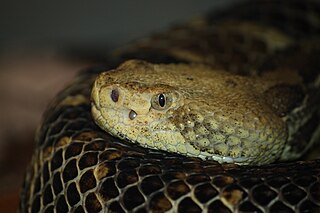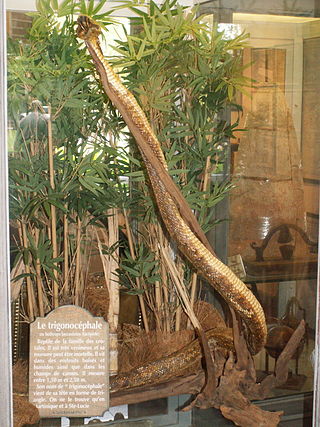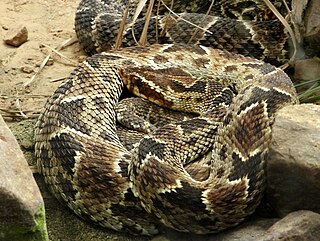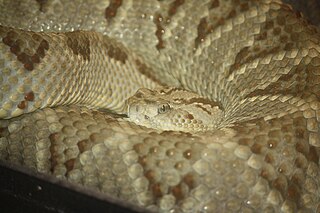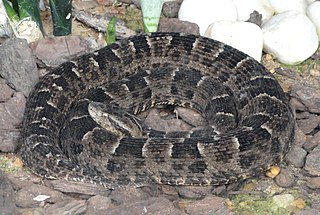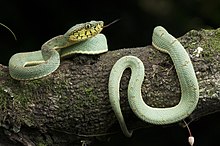| Image [3] | Species [3] | Subsp.* [3] | Common name [2] | Geographic range [1] |
|---|
 | B. alcatraz Marques, Martins, & Sazima, 2002 | 0 | Alcatrazes lancehead | Alcatrazes Island, São Paulo state, Southeastern Brazil. |
 | B. alternatus A.M.C. Duméril, Bibron & A.H.A. Duméril, 1854 | 0 | Urutu, yarará, víbora de la cruz | Southeastern Brazil, Paraguay, Uruguay and northern Argentina (in the provinces of Buenos Aires, Catamarca, Córdoba, Corrientes, Chaco, Entre Ríos, Formosa, La Pampa, Misiones, San Luis, Santa Fe, Santiago del Estero and Tucumán. |
 | B. ammodytoides Leybold, 1873 | 0 | Patagonian lancehead | Argentina in the provinces of Buenos Aires, Catamarca, Córdoba, Chubut, La Pampa, La Rioja, Mendoza, Neuquén, Río Negro, San Juan, San Luis, Santa Cruz and Tucumán |
 | B. asper (Garman, 1884) | 0 | terciopelo (preferred), Fer-de-lance (commonly used, but incorrect) | Atlantic lowlands of eastern Mexico and Central America, including Guatemala, Belize, Honduras, Nicaragua, Costa Rica and Panama, a disjunct population occurs in southeastern Chiapas (Mexico) and southwestern Guatemala, northern South America in Colombia and Ecuador West of the Andes, westernmost Venezuela, and Tumbes, Peru. [2] |
 | B. atrox (Linnaeus, 1758) | 0 | Common lancehead | Tropical lowlands of South America east of the Andes, including southeastern Colombia, southern and eastern Venezuela, Trinidad, Guyana, Suriname, French Guiana, eastern Ecuador, eastern Peru, northern Bolivia and the northern half of Brazil |
| B. ayerbei Folleco-Fernandez, 2010 | 0 | Patian lancehead, Ayerbe's lancehead | Cauca, Colombia |
| B. barnetti Parker, 1938 | 0 | Barnett's lancehead | Along the Pacific coast of northern Peru at low elevations in arid, tropical scrub |
| B. bilineatus (Wied-Neuwied, 1825) | 2 | Two-striped forest-pitviper | Amazon region of South America: Colombia, Venezuela, Guyana, Suriname, French Guiana, Brazil, Ecuador, Peru and Bolivia. An isolated population is known from the Atlantic versant of southeastern Brazil. |
 | B. brazili Hoge, 1954 | 0 | Brazil's lancehead | Equatorial forests of eastern Peru, eastern Ecuador, Brazil and northern Bolivia |
 | B. caribbaeus (Garman, 1887) | 0 | Saint Lucia lancehead | St. Lucia, Lesser Antilles, apparently restricted to the low elevation periphery of all but the southern third and extreme northern tip of the island |
 | B. chloromelas (Boulenger, 1912) | 0 | Inca forest-pitviper | central Andes of Peru |
| B. cotiara (Gomes, 1913) | 0 | Cotiara | Araucaria forests of southern Brazil in the states of São Paulo, Paraná, Santa Catarina and Rio Grande do Sul, northeastern Argentina in Misiones Province |
 | B. diporus Cope, 1862 | 0 | Painted Lancehead | Argentina, Brazil, Paraguay, Bolivia |
 | B. erythromelas Amaral, 1923 | 0 | Caatinga lancehead | Northeastern Brazil in the states of Alagoas, Bahia, Ceará, extreme eastern Maranhão, Minas Gerais, Paraíba, Pernambuco, Piauí, Rio Grande do Norte and Sergipe |
 | B. fonsecai Hoge & Belluomini, 1959 | 0 | Fonseca's lancehead | Southeastern Brazil in the states of northeastern São Paulo, southern Rio de Jeneiro and extreme southern Minas Gerais |
| B. germanoi Barbo, Booker, Duarte, Chaluppe, Portes-Junior, Franco, & Grazziotin, 2022 | 0 | Moela's lancehead | Ilha da Moela, Brazil |
 | B. insularis (Amaral, 1922) | 0 | Golden lancehead | Queimada Grande Island, São Paulo State, Brazil |
 | B. itapetiningae (Boulenger, 1907) | 0 | São Paulo lancehead | Southeastern Brazil in the states of Minas Gerais, Mato Grosso, São Paulo, and on the Paraná Plateau |
| B. jabrensis Barbo, Grazziotin, Pereira-Filho, Freitas, Abrantes, & Kokubum. 2022 | 0 | Jabre's lancehead | Paraíba, Brazil |
 | B. jararaca (Wied-Neuwied, 1824) | 0 | Jararaca | Southern Brazil, northeastern Paraguay and northern Argentina (Misiones) |
 | B. jararacussu Lacerda, 1884 | 0 | Jararacussu | Eastern Brazil (from Bahia to Santa Catarina), Paraguay, southeastern Bolivia and northeastern Argentina (Misiones Province) |
| B. jonathani (Harvey, 1994) | 0 | Jonathan's lancehead, Cochabamba lancehead | The Altiplano of central Bolivia in the departments of Cochabamba, Santa Cruz and Tarija, and in northwestern Argentina in the departments of Jujuy and Salta, occurring at elevations of 2000–3500 m in dry, rocky grassland |
| B. lanceolatus T(Bonnaterre, 1790) | 0 | Fer-de-lance, Martinique lancehead | Martinique, Lesser Antilles |
 | B. leucurus Wagler, 1824 | 0 | Whitetail lancehead, Bahia lancehead | Eastern Brazil along the Atlantic coast from northern Espírito Santo north to Alagoas and Ceará, occurs more inland in several parts of Bahia, uncertain identity of disjunct populations west of the Rio São Francisco |
| B. lutzi (Miranda-Ribeiro, 1915) | 0 | Cerrado lancehead | Northeastern Brazil in northern Piaui state |
| B. marajoensis Hoge, 1966 | 0 | Marajó lancehead | Northern Brazil in the coastal lowlands of the Amazon Delta |
 | B. marmoratus Da Silva & Rodrigues, 2008 | 0 | Marbled lancehead | Goiás, Brazil |
 | B. mattogrossensis Amaral, 1925 | 0 | Mato Grosso lancehead | Brazil, Bolivia, Argentina, Peru |
| B. medusa (Sternfeld, 1920) | 0 | Venezuelan forest-pitviper | Venezuela, including the Cordillera de la Costa (coastal range), the Federal District and the states of Aragua, Bolívar and Carabobo. |
| B. monsignifer Timms, Chaparro, Venegas, Salazar-Valenzuela, Scrocchi, Cuevas, Leynaud, & Carrasco, 2019 | 0 | | Eastern slopes of the Andes of Bolivia and southern Peru |
 | B. moojeni Hoge, 1966 | 0 | Brazilian lancehead | Central and southeastern Brazil, eastern Paraguay, northeastern Argentina (Misiones) and likely eastern Bolivia |
| B. muriciensis Ferrarezzi & Freire, 2001 | 0 | | Mata de Murici, Alagoas state, Northeastern Brazil |
 | B. neuwiedi Wagler, 1824 | 7 | Neuwied's lancehead | South America east of the Andes and south of 5°S, including Brazil (southern Maranhão, Piauí, Ceará, Bahia, Goiás, Mato Grosso, an isolated population in Amazonas, Rondônia and all southern states), Bolivia, Paraguay, Argentina (Catamarca, Córdoba, Corrientes, Chaco, Entre Ríos, Formosa, Jujuy, La Pampa, La Rioja, Mendoza, Misiones, Salta, San Juan, San Luis, Santa Fe, Santiago del Estero and Tucumán) and Uruguay |
| B. oligobalius Dal Vechio, Prates, Grazziotin, Graboski & Rodrigues, 2021 | 0 | | Amazonian forests of southern Colombia, southern Venezuela, Guyana, Suriname, French Guiana and Brazil north of the Amazon/Solimões |
| B. oligolepis (F. Werner, 1901) | 0 | Peruvian forest-pitviper | Eastern slopes of the Andes in Peru and Bolivia. |
| B. osbornei Freire-Lascano, 1991 | 0 | | Western Ecuador, Northwestern Peru |
| B. otavioi Barbo, Grazziotin, Sazima, Martins, & Sawaya, 2012 | 0 | | Vitória Island, São Paulo, Brazil |
 | B. pauloensis Amaral, 1925 | 0 | | Brazil, Paraguay, Bolivia |
| B. pictus (Tschudi, 1845) | 0 | Desert lancehead | Peru on the hills of the Pacific coastal region and versant up to about 1800 m elevation |
| B. pirajai Amaral, 1923 | 0 | Piraja's lancehead | Brazil in central and southern Bahia state and possibly also Minas Gerais |
| B. pubescens (Cope, 1870) | 0 | | Brazil, Uruguay |
| B. pulcher (W. Peters, 1862) | 0 | Andean forest-pitviper | Eastern slopes of the Andes from south-central Colombia to southern Ecuador. |
| B. punctatus (García, 1896) | 0 | Chocoan lancehead | From the Darién of Panama along the Pacific slope of Colombia and Ecuador. |
| B. sanctaecrucis Hoge, 1966 | 0 | Bolivian lancehead | Bolivia in the Amazonian lowlands from the departments of El Beni to Santa Cruz |
| B. sazimai Barbo, Gasparini, Almeida, Zaher, Grazziotin, Gusmão, Ferrarini, & Sawaya, 2016 | 0 | Franceses Island lancehead | Ilha dos Franceses, Espírito Santo, Brazil |
| B. sonene Carrasco, Grazziotin, Cruz-Farfan, Koch, Ochoa, Scrocchi, Leynaud, & Chaparro, 2019 | 0 | | Madre de Dios, Peru |
| B. taeniatus (Wagler, 1824) | 2 | Speckled forest-pitviper | Widespread in the equatorial forests of Ecuador, Colombia, Venezuela, Guyana, Suriname, French Guiana, Brazil, Peru and Bolivia. |
 | B. venezuelensis Sandner-Montilla, 1952 | 0 | Venezuelan lancehead | Northern and central Venezuela, including the Cordillera de la Costa (coast range) and the states of Aragua, Carabobo, the Federal District, Miranda, Mérida, Trujillo, Lara, Falcón, Yaracuy and Sucre, and Colombia (Norte de Santander and Boyacá departments |
|



























